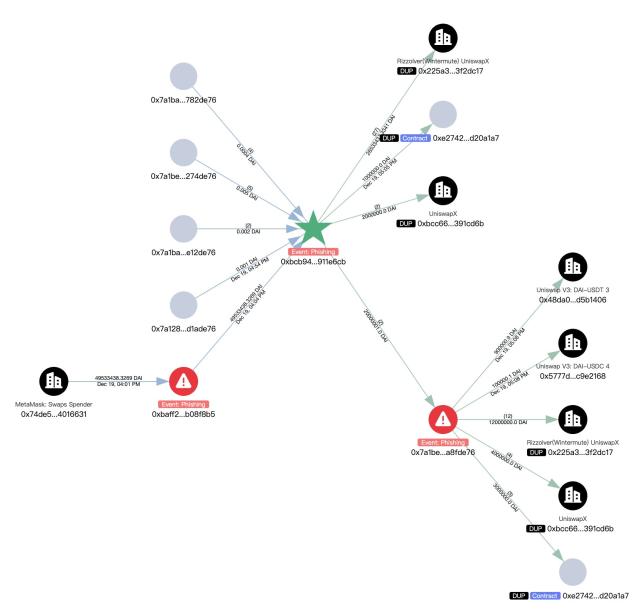In the past 2023, the Ordinals theory and protocol, which were born based on the two technological innovations of Segregated Witness and Taproot upgrade, unexpectedly pushed Bitcoin, the strongest decentralized consensus, to begin to transcend its single narrative of "value storage". Ordinals Protocol, and BRC-20 based on or inspired by it, Runes Protocol, Atomic Protocol, DMT Digital Material Theory, NAT Non-arbitrary Token, Bitmap and other theories, protocols, token standards, and projects are emerging in endlessly, and are preparing for digitalization. , the cornerstone of building a decentralized value network in an intelligent future.

Author: BIT FM
X/Tweet: @bitfm2024
On March 9, a 3.97MB Runestone, the largest Ordinals inscription to date, was successfully auctioned for 8 Bitcoins ($544,713). Its creator, well-known Ordinals V Leonidas, said that all proceeds from the auction, together with the 2.25 Bitcoins previously raised in the industry through Twitter, will be used to pay for the network fees of the Runestone airdrop plan. The largest Ordinals airdrop in history is about to begin. , and also made the Bitcoin community around the world full of enthusiasm for the Runes Protocol, which is planned to be launched on the mainnet when the Bitcoin block height is halved at 840,000 (that is, in late April 2024).
Why was Runes Protocol born?
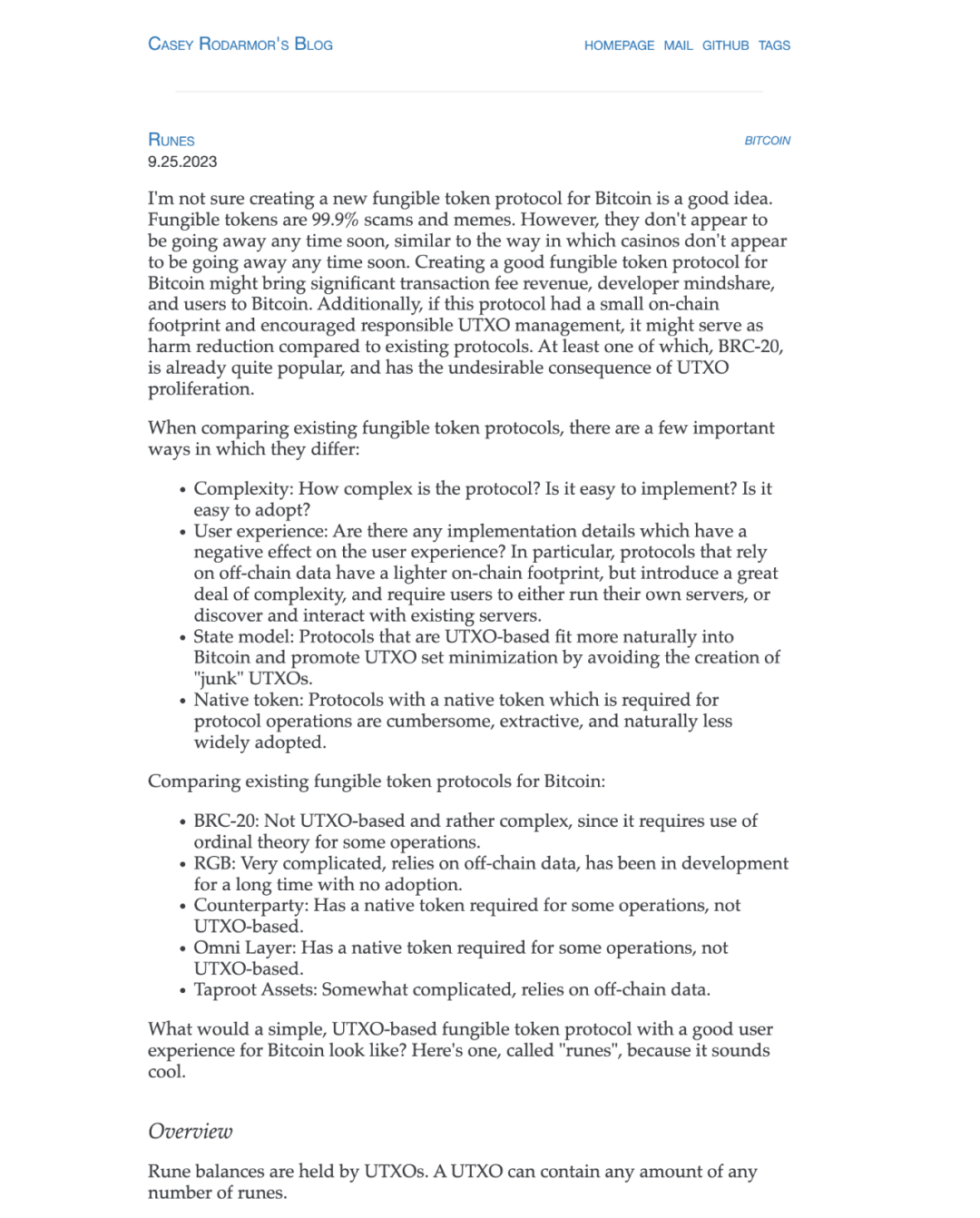
https://casey.github.io/blog/runes/
Runes Protocol is a Bitcoin UTXO (unspent transaction output) model proposed by Ordinals Protocol developer Casey on September 26 last year. He was not satisfied with the BRC-20 token standard born in March 2023 and used the Ordinals protocol to create a large amount of "dust" UTXO. The Fungible Token protocol manages and transfers FT through simple tuples (ID, OUTPUT, AMOUNT) and OP_RETURN operations.
Unlike RGB Protocol and Taproot Assets Protocol, which require off-chain data storage and retrieval infrastructure, or BRC-20’s problem of producing “dust” UTXOs that occupy Bitcoin’s precious block space, Runes Protocol has a simple design and does not require additional off-chain data. Or native tokens can support some operations, optimizing on-chain data usage and improving user experience.
The Runes project is ahead of the game, what new ways to play?
Although Runes Protocol is still in the process of code programming optimization and version iteration, the PIPE protocol and RuneAlpha’s COOK rune token took the lead in December last year. Since January this year, more Runes projects have sprung up, and they Together with its innovative gameplay, it has attracted more and more attention and funds from the market, ranking at the forefront of the popularity of the Bitcoin ecosystem.
1. RSIC

RSIC is the abbreviation of Rune Specific Inscription Circuits. It is an NFT on Ordinals. The total amount is 21,000. 10% is retained by the project party. 90% of the RSIC is airdropped to the holder by the project party at its own expense, costing more than 3 Bitcoins. The layout is highly praised by the community. The specific airdrop rules and standards have not been announced, and it is speculated that they are mainly based on the blue-chip NFT held by the wallet. Because it is an airdrop, some wallets do not know that they have received the NFT, so they need to make a transfer (buy, sell/transfer to yourself) before it can be activated. After activation, "mining" begins, and what is mined is the share of a certain token deployed by the future project party in Runes. It is said that the RSIC project team and Node Monkey have the same founder, a colleague who wrote the Ordinals protocol with Casey in the early days, so it received rapid support from the Ordiscan browser.
Rules of play:
Involved elements:
🔹 #126 (Great Grandfather Inscription): An inscription that says deploying more inscriptions, suspected to be held by Bitcoin Rocks.
Great-grandfather’s inscription: https://ordiscan.com/inscription/126
🔹 RSIC Factory (Grandfather Inscription): Used to produce the RSIC distribution center. It has been entered into the Satoshi Nakamoto address (equivalent to the project party having destroyed the inscription and can no longer use it to continue to produce its sub-inscriptions). The grandfather inscription is still used Arrived at Metaprotocol.
🔹 RSIC distribution center: 10 in total, used to produce RSIC, all of which have been entered into Satoshi Nakamoto’s address. RSIC: Rune Specific Inscription Circuits, 21,000 in total (10% reserved by the project party)
🔹 Rune: The rune tokens mentioned by the project team will be distributed to holders (i.e. mined) in the future. They have not yet been named (hereinafter temporarily referred to as RS tokens) and will be deployed and distributed after the Runes mainnet is launched.
Interesting design:
🔹 Holding activated RSIC, you will get at least 21 RS tokens for each block. The longer you hold it, the more tokens you will get. Even if you sell it, the quota during the holding period will still be recorded in your wallet. superior.
🔹 There is a symbol in the lower right corner of each RSIC inscription, corresponding to different numbers and letters. When the last digit of the block hash value of a certain block is consistent with the RSIC symbol held, 336 RS can be obtained in this block Tokens, and the symbol in the lower right corner will be highlighted and turn yellow.
🔹 Each RSIC inscription refers to the same Javascript inscription. This inscription will grab the block hash of the latest block, analyze whether the last digit is consistent with the symbol in the lower right corner of RSIC, and change the style (turn yellow) when consistent. A similar setting is used in the little owl inscription of BRC333, which recurses to the javascript inscription to realize the change of the inscription over time.
🔹 The project team will put up a billboard for querying the RS token quota, so you don’t have to keep staring at the inscription to see if it will change color.
An easter egg: the rules of the boost logic mentioned in the white paper will be engraved on the 4703400000000 satoshi.
Summarize:
🔹 The project team is proficient in technology, and the issuance process uses father-son inscriptions, Metaprotocol fields, recursive inscriptions, Javascript inscriptions to call block data, and the deployment and distribution of the Rune protocol.
🔹 The gameplay is carefully designed, such as airdropping to high-value NFT holders, using activation operations to filter dormant wallets, adding random settings to increase attention and topicality, releasing and controlling the rhythm 3 months before the launch of the Rune protocol, etc.
🔹 However, RSIC also has a lot of centralization, which may be FUD in the future: airdrop rules, future token deployment, 10% reserved by the project team, etc.
🔹 This may be a relatively less decentralized solution in the Runes protocol's future method of issuing tokens to projects with a fixed total amount and then airdropping them, and is easily accepted by the community.
Official website: https://runecoin.io Official Twitter: @rune_coin collection: https://magiceden.io/ordinals/marketplace/rsic mining query: http://ordiscan.com After entering the wallet address, in the Runes column Inquire
2. RSIC Boost
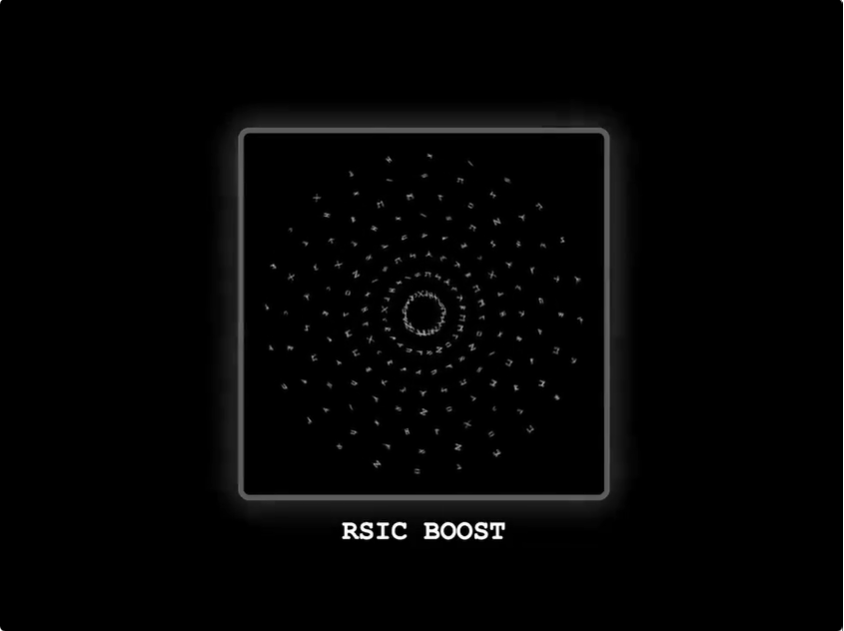
RSIC Boost is an easter egg embedded in the above-mentioned RSIC: an acceleration tool, with a total of 3900. This time it is not an airdrop, but a wallet holding RSIC is required to mint it (a network fee of more than 170 US dollars is required), which can accelerate the mining speed of RSIC. This move further screened out the active wallets on the chain, increased the market game play, and once again proved that the project team is very good at causing trouble.
Link collection: https://magiceden.io/ordinals/marketplace/rsic-boost
3. Runestone

Runestone is the most watched airdrop project after RSIC and is led by Leonidas, founder of Ordinal browser Ord.io. For more than a month, in order to pay for airdrop gas expenses, Leonidas has been raising funds from the industry through Twitter (each person donated 0.15 BTC × 15 people = 2.25 BTC). The fundraising has been completed, of which RSIC provided a donation of 0.15 BTC. .
The total amount of Ruestone is 112,383, and its airdrop rules are relatively transparent, that is, at block height 826,600, the wallet needs to hold 3 inscriptions, but inscriptions starting with text/plain or application/json (such as BRC-20 inscriptions) are excluded ). Currently, the number of whitelist wallet addresses published by Runestone reaches 113,376. According to news on March 3, the father's inscription has been engraved; on March 9, the Runestone auction set a record of 8 Bitcoins, and the large-scale airdrop is about to begin.
Whitelist query: https://runestone.lfg.cashhttps://www.okx.com/cn/web3/toolkit/btc-airdrop collection: None Mining query: None
4. Rune Mania Miner
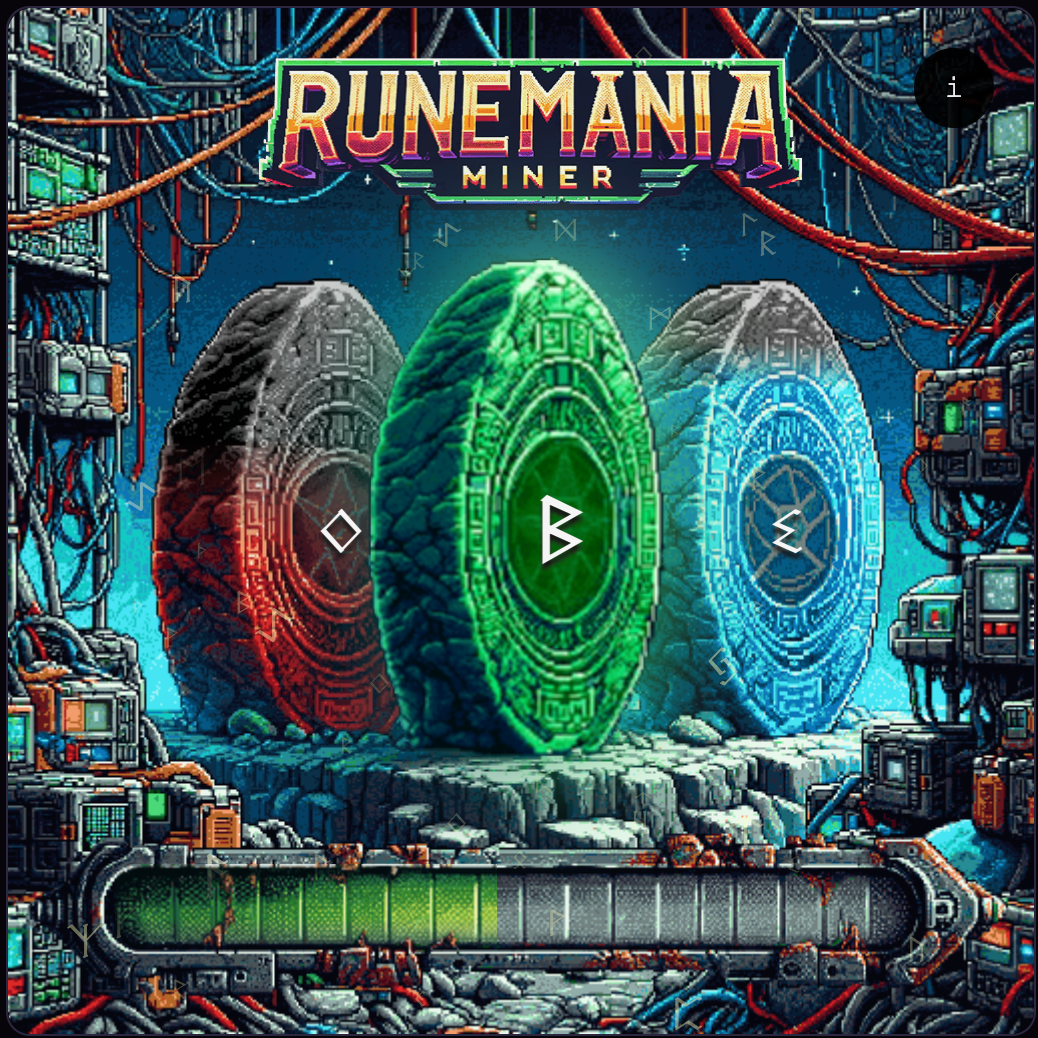
Sure enough, soon a project team sent an airdrop to RSIC Boost holders (who also held RSIC), namely Rune Mania Miner (hereinafter referred to as RMM). The total amount is 3,800, of which 253 are reserved by the team and 3,547 are airdropped to the community. Like RSIC, you also need to transfer it once (you can also transfer it to yourself) to activate mining, and the mining rules are more complicated.
Rules of play:
Each RMM has an initial coefficient of 1, and the basic mining amount is 10,000 rune tokens per block. There are a series of acceleration algorithms that can increase the mining speed coefficient, thus increasing the number of mines per block:
1️⃣ Mining Boost (hereinafter replaced by MB), the green progress bar at the bottom of the inscription is determined by the first two numbers of the inscription ID (if there are letters, skip it until the number is found, and take the first two numbers found), The minimum MB is 15, so the range is 15-99%, formula: MB/400 = coefficient bonus, for example, the number is 40, then 40/400=0.1, the mining speed coefficient is 1+0.1=1.1
2️⃣ Mana Boost is displayed on the red stone to the left of the inscription, and is determined by the last 2 numbers of the inscription. The minimum Mana is 10%, so the range is 10%-99%. The Mana bonus will only take effect when the total Mana value of all RMMs under a single address exceeds 100%. Suppose you have an RMM with 40% Mana. You can buy a few more cards to superimpose the Mana value to above 100%. At this time, you can get a coefficient bonus of 0.2 (all RMMs under this address enjoy this bonus).
3️⃣ Block Boost, displayed on the blue stone to the right of the inscription, is determined by the last two letters of the inscription and the current block height.
Static bonus: determined by the first two letters in the inscription ID (A=1, B=2...F=6), for example, ae is 15%, so the range is 11%-66%.
Dynamic bonus: determined by the current block height, increasing by 1% every 100 blocks. Maximum value is 89% (this value is reached during the halving block).
(Static bonus + dynamic bonus)/400 = Block boost coefficient bonus for this item.
In addition to the above 3 parameters, the gameplay of 4. Stone Boost and 5. Runes Boost has not yet been disclosed. Stone is the middle stone, and Rune boost is determined by the rune symbol on the middle stone. Judging from the white paper, it implies that holding two of the same rune symbols or holding three of the same rune symbols will have respective bonuses. The final number of each block mined = 10000* (basic coefficient 1 + all bonus coefficients).
Open any RMM on Magic Eden, and you can view the parameters introduced above in Attributes in the lower right corner.
Official Twitter: @RuneManiaMiner Official website: https://runemania.com/Document: https://rune-mania.gitbook.io/rmm/Collection: https://magiceden.io/ordinals/marketplace/rmm mining speed coefficient Queryer: https://www.ord.io/61927031
5. The Rune Guardians
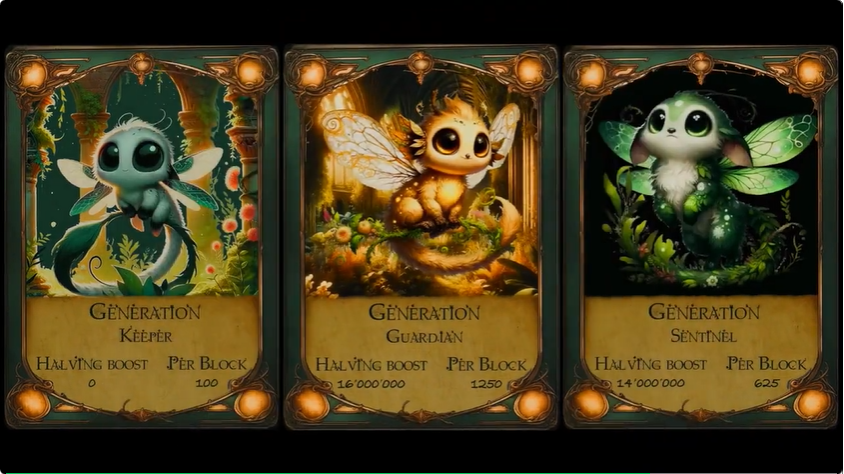
The gameplay of The Rune Guardians is similar to RSIC. It airdrops to Ordinals blue-chip NFT holders, and the project party bears all gas costs.
Rules of play:
The total number of The Rune Guardians is 10,000, divided into 100 Guardians, 200 Sentinels, and 9,700 Keepers. Holders who receive the airdrop can participate in dividing the total 100 billion runes. Click on the images of different levels of The Rune Guardians held in the Magic Eden connection wallet to display the rune mining balance.
Official Twitter: @RuneGuardians Official website: http://theruneguardians.com Collection: https://magiceden.io/ordinals/marketplace/trg Mining query: None yet
6. BTC Slugs
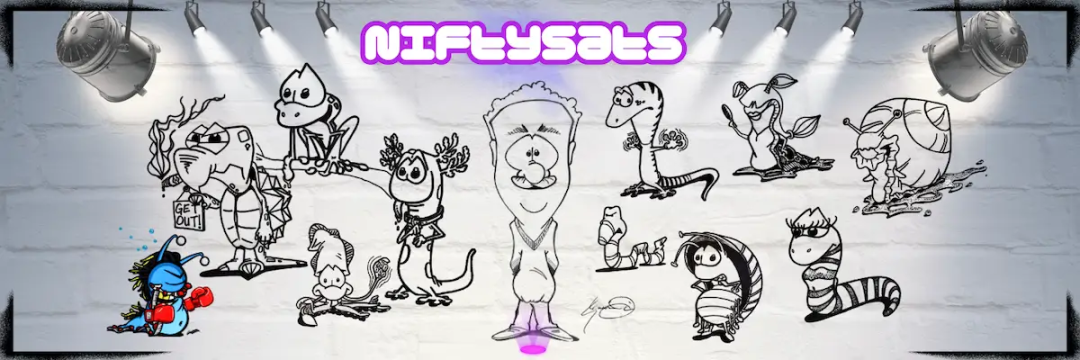
BTC Slugs (Bitcoin Sea Slugs) are the first NFT subset of the hand-drawn cartoon Bitcoin relic biosphere built by NiftySats. There are 3333 sea slugs in total. A whitelist is provided to holders who mint RISC Boost in the first 48 hours, and then the remaining 2201 minted for public sale at 0.0004 BTC ($20).
Rules of play:
The Bitcoin biosphere built by NiftySats is composed of cephalopods, arthropods, amphibians and reptiles. There are a total of 11,164 hand-drawn cartoon Ordinals, divided into 12 volumes, minted in order starting from BTC Slugs. Volume 1 has a total of 3,333 BTC Slugs. The supply then dwindles with each roll.
BTC Slugs have over 240 unique features, including antennae, body shape, butt feathers, mouth and more. Their accessories are also uncommon; instead of the usual hoodies, pipes, and hats, BTC Slugs' gear includes unicorn floats, boxing gloves, and GoPro snorkel masks, with some holy grail tentacles rocking lasers, rubies, and diamonds. . The rare characteristics of these BTC Slugs determine the rune rewards for the holder.
Rune rewards
🔹 Phase 1: After all BTC Slugs are minted and returned to their owners, the project will take a snapshot. At that time, anyone holding 3 Sea Slugs or more in a single wallet will receive 1,000 BRC-20 tokens $PERQ airdropped.
🔹 Phase 2: After the Runes Protocol is officially launched, the project will etch its own runes and distribute the supply to holders according to the rarity chart above. The rune symbols for NiftySats are paired with the Sea Slug trait in the same rarity order as RSIC. Since it is RSIC Boost holders who receive the first batch of BTC Slug, it only makes sense that the order of its rune symbols should be kept separate from that of RSIC. If one of your Nudibranchs has more than one qualifying trait, it will receive a higher reward allocation, while the lower reward allocation will go into the public pool and be distributed equally to all wallets holding 1 or more Nudibranchs.
BRC-20 Token$PERQ Reward
🔹 The project team will also take a second PERQ snapshot when Bitcoin block 840000 is halved, and allocate 10 runes for each PERQ to holders. The total supply of PERQ is 5 million, which means that the airdrop can have a maximum of 50 million runes (10 runes x 5 million perq), which is equivalent to 23.8% of the total supply of 210 million runes.
🔹 However, the total number of BTC Slugs is 3333, which means that a maximum of 1111 wallets can hold 3 Slugs at any given time, and after accounting for distribution and integration, the final number may be lower than that.
🔹 This means that out of the 2 million available reserves, a maximum of 1.1 million $PERQ (1000 x 1111) have been reserved for this airdrop. The remaining reserves of approximately 1 million, plus any outstanding supply, will be held in the team wallet.
🔹 The expected baseline of 1 million+ PERQ, and the associated 10 million+ runes that will be retained, as well as any unallocated supply from either asset, will be used for future market and community building; the project party will never sell or Trade any kind of asset.
The OG NiftyPass designed by the project party and $PERQ have different numbers and qualifications for obtaining the whitelist in all 12-volume NFT series. See the figure below for details.
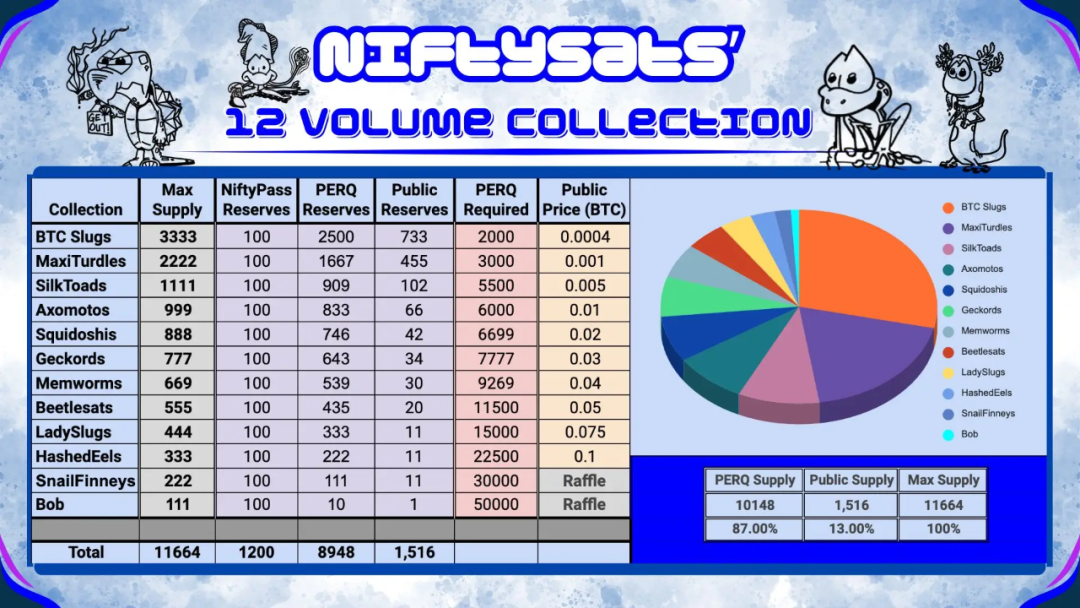
Official Twitter: @niftysats Official website: https://www.niftysats.com/Document: https://niftysats.gitbook.io/niftysats/Collection: https://magiceden.io/ordinals/marketplace/btc_slugs
What Alpha clues can we glean from Runes?
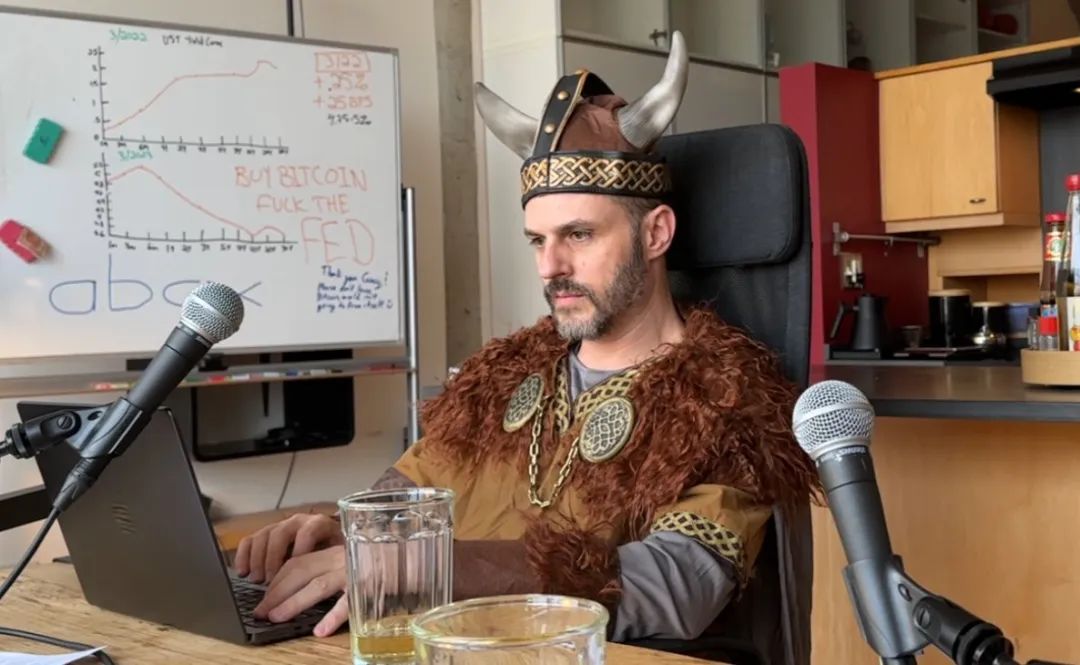
As the date for Runes Protocol to be launched on the mainnet, more Runes projects are on the way. The above project introduction can be seen:
Runes Protocol is the FT protocol launched by the founder of Ordinals Protocol to replace BRC-20. It is orthodox and more accepted by Western users and overseas communities.
From the perspective of design and ecology, Runes Protocol is not parallel to, but subordinate to, Ordinals Protocol. It combines inscriptions in the form of FT and NFT, and its asset issuance supports each other. The protocol design and ecological community are currently hotly debated in the market. The characteristics of "coin exchange" and "coin duality". Due to the organic combination with Bitcoin NFT, the current Runes ecosystem can attract more artists, influential NFT projects and communities to participate in its construction, and is generating more innovative gameplay.
Runes Protocol is designed to support two distribution methods:
1️⃣The fixed total amount (the project party directly inscribes all tokens and then distributes them) is a issuance method that tends to be centralized. At present, RSIC may become the leader of this method;
2️⃣Public engraving (fair mint after deploying tokens and setting parameters), similar to BRC-20, the biggest difference is that BRC-20 limits the total amount, while Runes limits the block height or timestamp, but does not limit the total amount, and it will be printed within the valid time How much is the total amount of tokens in the end.
The above-mentioned front-running projects before Runes was officially launched on the mainnet at the end of April all used airdrop mining machines to mine rune tokens and innovative GameFi gameplay to cold-start the projects and seize the minds and market share of Runes users.
Disclaimer: This article is for reference only and may not be used as legal, tax, investment, financial management or any other advice, and does not represent the position of RunesCC.






